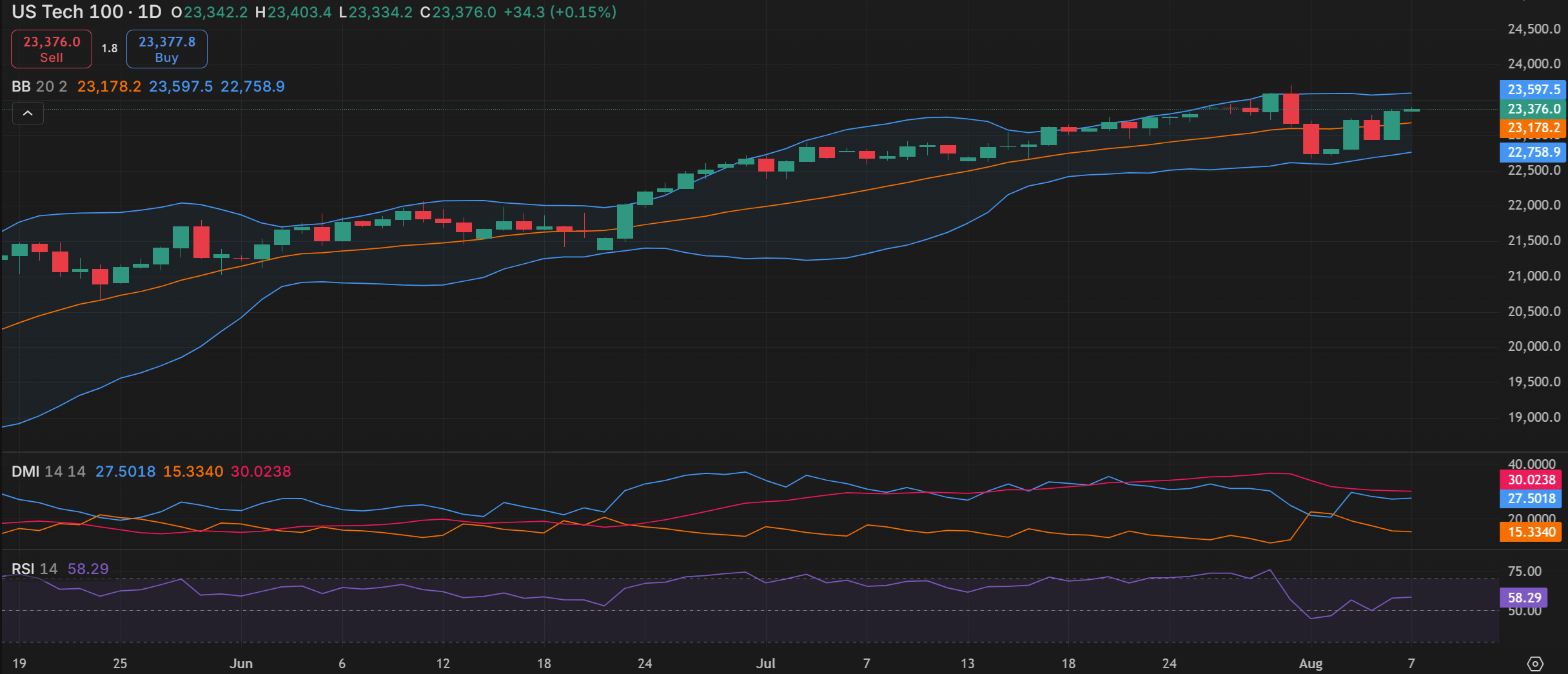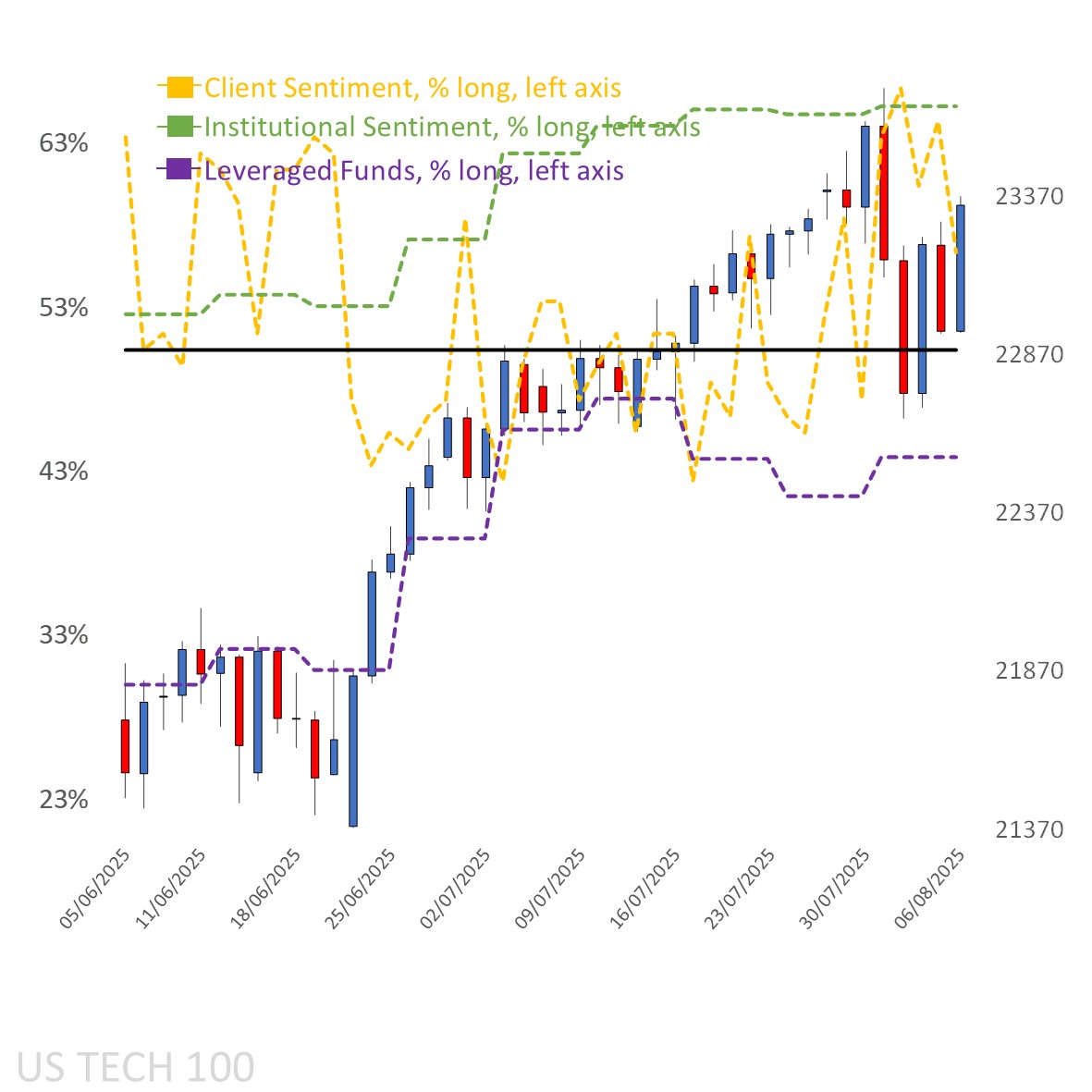Trading the Nasdaq 100 as Tariffs Take Effect
Not far off recovering from last Thursday’s losses buoyed by big gains from a few of Big Tech, and in sentiment still a story of majority buy bias.
US equity index futures are climbing after a session of gains for the S&P 500 (+0.7% to 6,345) and more so the tech-heavy Nasdaq 100 (+1.3% to 23,315) thanks to heavyweight component Apple enjoying big gains. Its shares closed over 5% higher and rose another 3% in extended trading as it’ll raise investment in domestic manufacturing in the US by $100bn to $600bn over the next four years. It wasn’t the only one among Big Tech enjoying big gains, with shares of Tesla jumping 3.6% by the close as CEO Musk says they’re training a new FSD model likely to be released at the end of next month.
Chipmakers were in focus following US President Trump’s plans to impose 100% tariffs on semiconductors and chips, but a crucial exception companies that build in the US translating into a positive for those with a presence. Shares of heaviest Nvidia closed higher up 0.7% in a mixed session for semiconductors as AMD suffered most down 6.4% due to its earnings release prior, where it missed on earnings and failed to impress on the AI front relying on other parts of its business to beat on revenue.
Treasury yields climbed slightly on the further end of the curve (10-year auction was a disappointment) while moved lower on the shorter end as market pricing (CME’s FedWatch) isn’t far off fully pricing in a rate cut in September, raising their odds of a second one in October, and via slight majority sees a third reduction in December. There was a dovish tilt when it came to central bank members speaking: Federal Reserve’s (Fed) Cook on the “concerning” jobs report where the revisions “are somewhat typical of turning points”, Daly on the “softened” labor market that’ll likely require the “need to adjust policy in the coming months”, Kashkari sees two rate cuts this year as “reasonable”, while Collins says it’s “still a wait-and-see”. There’s also the matter of replacing Kugler, with Trump saying that they’re “probably going to go with a temp and then a permanent” one, no doubt it'll be a dove that’ll push for rate cuts.
As for today, there’s the weekly claims at a time when the labor market is noted for any further weakness, the 30-year auction after what have been consecutive weak ones, more FOMC (Federal Open Market Committee) members speaking, further earnings, and assessing the impact from tariffs that are taking effect today.
Nasdaq 100’s technical overview, strategies and levels
The technical overview was and remains ‘consolidation – volatile’ on the daily time frame where key technical indicators were hit by last week’s hawkish hold out of the Fed followed by a weaker NFP (Non-Farm Payrolls) print, where breakout strategies are in the conformist camp with the idea of going with the move until it’s back to matching the weekly time frame’s ‘bull average’, with futures already above this week’s weekly 1st Resistance level.
Those anticipating a hold in this region fall in the contrarian camp on the daily time frame going for reversals, while for the weekly it’s sell strategies given it would be in contrast to the weekly time frame’s bullish indicators and overview.
Breaking down the daily technicals, and price is back above all its moving averages and not too far off the upper end of the band that roughly coincides with the previous record close, on the DMI (Directional Movement Index) front the +DI back above the -DI after a brief negative cross that failed to give much follow-through, an ADX (Average Directional Movement Index) still in trending territory), and an RSI (Relative Strength Index) rising but well beneath overbought territory. It won’t take much to shift the technical overview back to ‘bull average’, though working with a wider band compared to before meaning if buying off the 1st Support ideally doing so only after a significant reversal else risk getting stopped out.
Capital.com’s client sentiment for Nasdaq 100
In sentiment, it’s a story of majority long sentiment among Capital.com’s clients, but where price gains have enticed longs into closing out and shorts into initiating and taking that buy bias from near-heavy long 64% to 56% in just one day.
CoT speculators were and still are net long, raising it a notch to a heavy buy 65% on an increase in longs (by 8,040 lots) outdoing a smaller increase in shorts (by 3,514). Keep in mind that when it comes to the remaining key US equity indices they are net sell S&P (63%), so too the Russell (71%) and shifted in the Dow (to net short 55% from a previous net long 52%).
Client sentiment mapped on the daily chart
Source: Capital.com
Period: JUNE 2025 – AUGUST 2025
Past performance is not an indicator of future results.
Nasdaq 100’s chart on Capital.com platform with key technical indicators

Source: Capital.com
Period: MAY 2025 – AUGUST 2025
Past performance is not an indicator of future results.
RISK DISCLAIMER
CFDs are complex instruments and come with a high risk of losing money rapidly due to leverage. 82.12% of retail investor accounts lose money. You should consider whether you understand how CFDs work and whether you can afford to take the high risk of losing your money.
Past performance is no guarantee of future results. Professional clients can lose more than they deposit. All trading involves risk.
RESEARCH DISCLAIMER
THE PRESENT MATERIAL MUST BE REGARDED AS MARKETING COMMUNICATION AND SHOULD NOT BE INTERPRETED AS INVESTMENT RESEARCH OR INVESTMENT ADVICE.
The content of this communication has been prepared solely for information purposes and should be considered as such. This communication does not constitute research in accordance with the legal requirements designed to promote investment research independence. While the information in this communication, or on which this communication is based, has been obtained from sources that Capital.com believes to be reliable and accurate, it has not undergone independent verification. No representation or warranty, whether expressed or implied, is made as to the accuracy or completeness of any information obtained from third parties.
The information provided as at the date of this communication is subject to change without prior notice. It does not take into consideration the investors’ individual circumstances or objectives and should not be construed as specific advice on the suitability of any investment decision. Investors should consider this report as merely one factor in making any investment decisions. To the extent permitted by law, neither Capital.com nor any of its employees or affiliates accept any liability whatsoever for any direct or consequential loss arising, directly or indirectly, from any use of this communication or its contents. Any person acting on the information does so entirely at their own risk. Any information that may be provided in this communication relating to past performance is not a reliable indicator of future results or performance.
Capital Com Online Investments Ltd is a limited liability company with company number 209236B. Capital Com Online Investments Ltd is a Company registered in the Commonwealth of The Bahamas and authorised by the Securities Commission of The Bahamas with license number SIA-F245. The Company’s registered office is at #3 Bayside Executive Park, Blake Road and West Bay Street, P. O. Box CB 13012, Nassau, The Bahamas.


